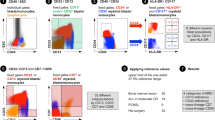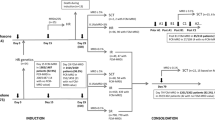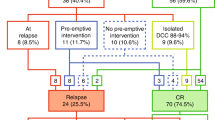Abstract
Minimal residual disease (MRD) quantification is widely used for therapeutic stratification in pediatric acute lymphoblastic leukemia (ALL). A robust, reproducible, sensitivity of at least 0.01% has been achieved for IG/TCR clonal rearrangements using allele-specific quantitative PCR (IG/TCR-QPCR) within the EuroMRD consortium. Whether multiparameter flow cytometry (MFC) can reach such inter-center performance in ALL MRD monitoring remains unclear. In a multicenter study, MRD was measured prospectively on 598 follow-up bone marrow samples from 102 high-risk children and 136 adult ALL patients, using IG/TCR-QPCR and 4/5 color MFC. At diagnosis, all 238 patients (100%) had at least one suitable MRD marker with 0.01% sensitivity, including 205/238 samples (86%) by using IG/TCR-QPCR and 223/238 samples (94%) by using MFC. QPCR and MFC were evaluable in 495/598 (83%) samples. Qualitative results (<0.01% or ⩾0.01%) concurred in 96% of samples and overall positivity (including <0.01% and nonquantifiable positivity) was concurrent in 84%. MRD values ⩾0.01% correlated highly (r2=0.87) and 69% clustered within half-a-log10. QPCR and MFC can therefore be comparable if properly standardized, and are highly complementary. MFC strategies will benefit from a concerted approach, as does molecular MRD monitoring, and will contribute significantly to the achievement of 100% MRD informativity in adult and pediatric ALL.
This is a preview of subscription content, access via your institution
Access options
Subscribe to this journal
Receive 12 print issues and online access
$259.00 per year
only $21.58 per issue
Buy this article
- Purchase on Springer Link
- Instant access to full article PDF
Prices may be subject to local taxes which are calculated during checkout



Similar content being viewed by others
References
van Dongen JJ, Seriu T, Panzer-Grumayer ER, Biondi A, Pongers-Willemse MJ, Corral L et al. Prognostic value of minimal residual disease in acute lymphoblastic leukaemia in childhood. Lancet 1998; 352: 1731–1738.
Cavé H, van der Werff ten Bosch J, Suciu S, Guidal C, Waterkeyn C, Otten J et al. Clinical significance of minimal residual disease in childhood acute lymphoblastic leukemia. European organization for research and treatment of cancer – childhood leukemia cooperative group. N Engl J Med 1998; 339: 591–598.
Coustan-Smith E, Sancho J, Hancock ML, Boyett JM, Behm FG, Raimondi SC et al. Clinical importance of minimal residual disease in childhood acute lymphoblastic leukemia. Blood 2000; 96: 2691–2596.
Borowitz MJ, Devidas M, Hunger SP, Bowman WP, Carroll AJ, Carroll WL et al. Clinical significance of minimal residual disease in childhood acute lymphoblastic leukemia and its relationship to other prognostic factor. A Children’s Oncology Group study. Blood 2008; 111: 5477–5485.
Conter V, Bartram CR, Valsecchi MG, Schrauder A, Panzer-Grümayer R, Möricke A et al. Molecular response to treatment redefines all prognostic factors in children and adolescents with B-cell precursor acute lymphoblastic leukemia: results in 3184 patients of the AIEOP-BFM ALL 2000 study. Blood 2010; 115: 3206–3214.
Schrappe M, Valsecchi MG, Bartram CR, Schrauder A, Panzer-Grümayer R, Möricke A et al. Late MRD response determines relapse risk overall and in subsets of childhood T-cell ALL: results of the AIEOP-BFM-ALL 2000 study. Blood 2011; 118: 2077–2084.
Brüggemann M, Raff T, Flohr T, Gokbuget N, Nakao M, Droese J et al. Clinical significance of minimal residual disease quantification in adult patients with standard-risk acute lymphoblastic leukemia. Blood 2006; 107: 1116–1123.
Patel B, Rai L, Buck G, Richards SM, Mortuza Y, Mitchell W et al. Minimal residual disease is a significant predictor of treatment failure in non T-lineage adult acute lymphoblastic leukaemia: final results of the international trial UKALL XII/ECOG2993. Br J Haematol 2010; 148: 80–89.
van der Velden VHJ, Wijkhuijs JM, Jacobs DC, van Wering ER, van Dongen JJ . T cell receptor gamma gene rearrangements as targets for detection of minimal residual disease in acute lymphoblastic leukemia by real-time quantitative PCR analysis. Leukemia 2002; 16: 1372–1380.
Verhagen OJ, Willemse MJ, Breunis WB, Wijkhuijs AJ, Jacobs DC, Joosten SA et al. Application of germline IGH probes in real-time quantitative PCR for the detection of minimal residual disease in acute lymphoblastic leukemia. Leukemia 2000; 14: 1426–1435.
van der Velden VHJ, Willemse MJ, van der Schoot CE, Hahlen K, van Wering ER, van Dongen JJ . Immunoglobulin kappa deleting element rearrangements in precursor-B acute lymphoblasticleukemia are stable targets fordetection of minimalresidualdiseaseby real-time quantitative PCR. Leukemia 2002; 16: 928–936.
Bruggemann M, van der Velden VHJ, Raff T, Droese J, Ritgen M, Pott C et al. Rearranged T-cell receptor beta genes represent powerful targets for quantification of minimal residual disease in childhood and adult T-cell acute lymphoblastic leukemia. Leukemia 2004; 18: 709–719.
van der Velden VHJ, Panzer-Grumayer ER, Cazzaniga G, Flohr T, Sutton R, Schrauder A et al. Optimization of PCR-based minimal residual disease diagnostics for childhood acute lymphoblastic leukemia in a multi-center setting. Leukemia 2007; 21: 706–713.
Campana D, Coustan-Smith E . Advances in the immunological monitoring of childhood acute lymphoblastic leukaemia. Best Pract Res Clin Haematol 2002; 15: 1–19.
Bjorklund E, Mazur J, Soderhall S, Porwit-MacDonald A . Flow cytometric follow-up of minimal residual disease in bone marrow gives prognostic information in children with acute lymphoblastic leukemia. Leukemia 2003; 17: 138–148.
Dworzak MN, Fröschl G, Printz D, Mann G, Pötschger U, Mühlegger N et al. Prognostic significance and modalities of flow cytometric minimal residual disease in childhood acute lymphoblastic leukemia. Blood 2002; 99: 1952–1958.
Pongers-Willemse MJ, Seriu T, Stolz F, d’Aniello E, Gameiro P, Pisa P et al. Primers and protocols for standardized detection of minimal residual disease in acute lymphoblastic leukemiausing immunoglobulin and T cell receptor gene rearrangements and TAL1 deletions as PCR targets: report of the BIOMED-1 CONCERTED ACTION: investigation of minimal residual disease in acute leukemia. Leukemia 1999; 13: 110–118.
van Dongen JJ, Langerak AW, Bruggemann M, Evans PA, Hummel M, Lavender FL et al. Design and standardization of PCR primers and protocols for detection of clonal immunoglobulin and T-cell receptor gene recombinations in suspect lymphoproliferations: report of the BIOMED-2 Concerted Action BMH4-CT98-3936. Leukemia 2003; 17: 2257–2317.
van der Velden VHJ, Cazzaniga G, Schrauder A, Hancock J, Bader P, Panzer-Grumayer ER et al. Analysis of minimal residual disease by Ig/TCR gene rearrangements: guidelines for interpretation of real-time quantitative PCR data. Leukemia 2007; 21: 604–611.
Brüggemann M, Schrauder A, Raff T, Pfeifer H, Dworzak M, Ottmann OG et al. Standardized MRD quantification in European ALL trials: proceedings of the Second International Symposium on MRD assessment in Kiel, Germany, 18-20 September 2008. Leukemia 2010; 24: 521–535.
Robillard N, Cavé H, Méchinaud F, Guidal C, Garnache-Ottou F, Rorhlich PS et al. Four-color flow cytometry bypasses limitations of polymerase chain reaction for minimal residual disease detection in certain subsets of children with acute lymphoblastic leukemia. Haematologica 2005; 90: 1516–1523.
Dworzak MN, Gaipa G, Ratei R, Veltroni M, Schumich A, Maglia O et al. Standardization of flow cytometric minimal residual disease evaluation in acute lymphoblastic leukemia: multicentric assessment is feasible. Cytometry B Clin Cytom 2008; 74: 331–340.
Irving J, Jesson J, Virgo P, Case M, Minto L, Eyre L et al. Establishment and validation of a standard protocol for detection of minimal residual disease in B lineage childhood acute lymphoblastic leukemia by flow cytometry in a multi-center setting. Haematologica 2009; 94: 870–874.
Björklund E, Matinlauri I, Tierens A, Axelsson S, Forestier E, Jacobsson S et al. Quality control of flow cytometry data analysis for evaluation of minimal residual disease in bone marrow from acute leukemia patients during treatment. J Pediatr Hematol Oncol 2009; 31: 406–415.
Neale GA, Coustan-Smith E, Stow P, Pan Q, Chen X, Pui CH et al. Comparative analysis of flow cytometry and polymerase chain reaction for the detection of minimal residual disease in childhood acute lymphoblastic leukemia. Leukemia 2004; 18: 934–938.
Malec M, van der Velden VHJ, Bjorklund E, Wijkhuijs JM, Soderhall S, Mazur J et al. Analysis of minimal residual disease in childhood acute lymphoblastic leukemia: comparison between RQ-PCR analysis of Ig/TcR gene rearrangements and multicolour flow cytometric immunophenotyping. Leukemia 2004; 18: 1630–1636.
Kerst G, Kreyenberg H, Roth C, Well C, Dietz K, Coustan-Smith E et al. Concurrent detection of minimal residual disease (MRD) in childhood acute lymphoblastic leukaemia by flow cytometry and real-time PCR. Br J Haematol 2005; 128: 774–782.
Bene MC, Castoldi G, Knapp W, Ludwig WD, Matutes E, Orfao A et al. Proposals for the immunological classification of acute leukemias. Leukemia 1995; 9: 1783–1786.
Pui CH, Campana D, Pei D, Bowman WP, Sandlund JT, Kaste SC et al. Treating childhood acute lymphoblastic leukemia without cranial irradiation. N Engl J Med 2009; 360: 2730–2741.
Coustan-Smith E, Song G, Clark C, Key L, Liu P, Mehrpooya M et al. New markers for minimal residual disease detection in acute lymphoblastic leukemia. Blood 2011; 117: 6267–6276.
Thörn I, Forestier E, Botling J, Thuresson B, Wasslavik C, Björklund E et al. Minimal residual disease assessment in childhood acute lymphoblastic leukaemia: a Swedish multi-centre study comparing real-time polymerase chain reaction and multicolour flow cytometry. Br J Haematol 2011; 152: 743–753.
Gaipa G, Cazzaniga G, Panzer-Grumayer RE, Veltroni M, Karawajew L, Silvestri D et al. Time point-dependent concordance of flow cytometry and RQ-PCR in the MRD detection in childhood ALL: the experience of the AIEOP-BFM- ALL MRD study group. Blood 2008; 112, abstract 700.
Stow P, Key L, Chen X, Pan Q, Neale GA, Coustan-Smith E et al. Clinical significance of low levels of minimal residual disease at the end of remission induction therapy in childhood acute lymphoblastic leukemia. Blood 2010; 115: 4657–4663.
Panzer-Grumayer ER, Schneider M, Panzer S, Fasching K, Gadner H . Rapid molecular response during early induction chemotherapy preditcs a good outcome in childhood acute lymphoblastic leukemia. Blood 2000; 95: 790–794.
Coustan-Smith E, Sancho J, Behm FG, Hancock ML, Razzouk BI, Ribeiro RC et al. Prognostic importance of measuring early clearance of leukemic cells by flow cytometry in childhood acute lymphoblastic leukemia. Blood 2002; 100: 52–58.
Basso G, Veltroni M, Valsecchi MG, Dworzak MN, Ratei R, Silvestri D et al. Risk of relapse of childhood acute lymphoblastic leukemia is predicted by flow cytometric measurement of residual disease on day 15 bone marrow. J Clin Oncol 2009; 27: 5168–5174.
Szczepanski T, Willemse MJ, van Wering ER, van Weerden JF, Kamps WA, van Dongen JJ . Precursor-B-ALL with D(H)-J(H) gene rearrangements have an immature immunogenotype with a high frequency of oligoclonality and hyperdiploidy of chromosome 14. Leukemia 2001; 15: 1415–1423.
Dworzak MN, Gaipa G, Schumich A, Maglia O, Ratei R, Veltroni M et al. Modulation of antigen expression in B-cell precursor acute lymphoblastic leukemia during induction therapy is partly transient: evidence for a drug-induced regulatory phenomenon. Results of the AIEOP-BFM-ALL-FLOW-MRD-Study Group. Cytometry B Clin Cytom 2010; 78: 147–153.
Roshal M, Fromm JR, Winter S, Dunsmore K, Wood BL . Immaturity associated antigens are lost during induction for T cell lymphoblastic leukemia: implications for minimal residual disease detection. Cytometry B Clin Cytom 2010; 78: 139–146.
Eckert C, Flohr T, Koehler R, Hagedorn N, Moericke A, Stanulla M et al. Very early/early relapses of acute lymphoblastic leukemia show unexpected changes of clonal markers and high heterogeneity in response to initial and relapse treatment. Leukemia 2011; 25: 1305–1313.
Acknowledgements
This work was supported by a grant ‘Soutien aux Techniques Innovantes et Coûteuses’ (STIC) by the French Institut National du Cancer (InCA) and benefited from support by the companies BD Biosciences and Beckman Coulter. We are grateful to all clinicians, biologists and clinical research assistants involved in the FRALLE, EORTC and GRAALL clinical trials, where the patients were enrolled. Special thanks are addressed to Véronique Lhéritier for her great help with the adult patients’database.
Author information
Authors and Affiliations
Corresponding authors
Ethics declarations
Competing interests
The authors declare no conflict of interest.
Additional information
Supplementary Information accompanies the paper on the Leukemia website
Supplementary information
Rights and permissions
About this article
Cite this article
Garand, R., Beldjord, K., Cavé, H. et al. Flow cytometry and IG/TCR quantitative PCR for minimal residual disease quantitation in acute lymphoblastic leukemia: a French multicenter prospective study on behalf of the FRALLE, EORTC and GRAALL. Leukemia 27, 370–376 (2013). https://doi.org/10.1038/leu.2012.234
Received:
Revised:
Accepted:
Published:
Issue Date:
DOI: https://doi.org/10.1038/leu.2012.234
Keywords
This article is cited by
-
Value of flow cytometry for MRD-based relapse prediction in B-cell precursor ALL in a multicenter setting
Leukemia (2021)
-
Disease escape with the selective loss of the Philadelphia chromosome after tyrosine kinase inhibitor exposure in Ph-positive acute lymphoblastic leukemia
Leukemia (2020)
-
Minimal residual disease quantification by flow cytometry provides reliable risk stratification in T-cell acute lymphoblastic leukemia
Leukemia (2019)
-
Hematopoietic stem cell transplantation for adults with Philadelphia chromosome-negative acute lymphoblastic leukemia in first remission: a position statement of the European Working Group for Adult Acute Lymphoblastic Leukemia (EWALL) and the Acute Leukemia Working Party of the European Society for Blood and Marrow Transplantation (EBMT)
Bone Marrow Transplantation (2019)
-
Improved outcome of children transplanted for high-risk leukemia by using a new strategy of cyclosporine-based GVHD prophylaxis
Bone Marrow Transplantation (2016)



